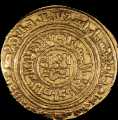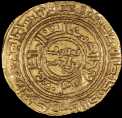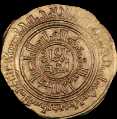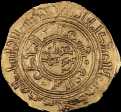Coins of the Egyptian Ayyubid Sultanate
History of the Ayyubid state (1171-1252)
The Bani Ayyub sultans came from a family of Kurdish origin. The merit of the creation of this state belongs to Salah ad-Din al-Ayyubi (in the European tradition, Saladin), who captured Egypt during the time of the Fatimids.
In 1169, Salah ad-Din was sent to help the Fatimid caliph against the crusaders, but after the death of the caliph in 1171, he announced the liquidation of the caliphate, and in 1174 proclaimed his independence and became the sultan of Egypt and the Levant.
After the unification of the state, Salah ad-Din declared jihad on the crusaders and won many victories, culminating in the capture of Jerusalem after the battle of Hattin in 583 AH (1187).
After the death of Salah ad-Din in 589 AH (1193), his beloved son Uthman succeeded to the throne, followed by Al-Mansur (1198).
However, Salah ad-Din's brother Saif ad-Din Abu Bakr seized the throne in 596 AH (1200), after which disagreements and conflicts began between members of the Ayyubid house. Each ruler began to manage his city semi-independently from the Sultan, as a result, the power of the Ayyubids weakened. During this period, the crusades resumed, which prompted the Ayubids to conclude treaties with the crusaders and cede to them many coastal cities in Palestine and the Levant.
The Bani Ayyub sultans continued to rule until the death of Turanshah in AH 648 (1250). He was killed by the Mamluks, who put an end to the Ayyubid state in Egypt.
Ayyubid dynasty in Egypt
- Nasser Salah-ad-din Yusuf bin Ayyub - 564-589 AH (1169-1193)
- Usman ibn Yusuf - 589-595 AH (1193-1999)
- Mansur Muhammad - 595-596 AH (1199-1200)
- Al-Adil Abu Bakr I - 596-615 AH (1200-1218)
- Al-Kamil Muhammad I - 615-635 AH (1218-1238)
- Al-Adil Abu Bakr II - 635-637 AH (1238-1240)
- Saleh Najm al-Din Ayub - 637-647 AH (1240-1249)
- Al-Muazzam Turanshah IV - 647-648 AH (1249-1250)
- Al-Ashraf Musa II - 648-652 AH (1250-1252)
Ayyubid dinar
The Ayyubids minted their coins at mints in Alexandria and Cairo, but some of their dinars were minted in very rare places such as Cairo citadel, Damascus and Mecca.
Salah al-Din al-Ayyubi initially minted his dinars in the style of Fatimid dinars with central inscriptions and three margins, except that these dinars bore the name of the Abbasid Caliph Al-Mustadi bi-Amr in the center of the obverse, and the name of the Sultan Salah ad-Din al-Ayyubi in the center of the reverse. There are also coins in the Fatimid style with two fields and a central inscription without gaps between them. In the later period of Saladin's reign, dinars were also minted in the Fatimid style, with central inscriptions surrounded by inscriptions on an inner field followed by two linear circles and then inscriptions on an outer field.
This style continued in the dinars of his successor Al-Aziz Uthman, his son Al-Mansur and Al-Malik Al-Adil, but the coins of the latter were struck with central inscriptions and a single field separated by two linear circles. During his reign and from 624 AH, dinars began to be minted in the Naskhi script instead of the Kufic script that had previously prevailed on dinars minted in Egypt.
In the era of the followers of Al-Kamil, dinars continued to be minted in the same way, and there were no changes in them, except for the mention of the names of these sultans, and the mention of the name of the modern Abbasid caliph. The coins of the last Sultan Bani Ayyub al-Muazzam Turanshah have not yet been found.
In addition to dinars, the Ayyubids minted their factions, but these coins are very rare.
The Crusaders minted imitations of the Ayyubid dinars, which are distinguished by Christian signs and many grammatical errors in the legends.
Salah-ad-din dinar

In the center:
Imam/Ahmed - المركز : الامام / أحمد
In the fields:
There is no god but Allah, Abu al-Abbas an-Nasser Li-Din Commander of the Faithful - الهامش : لا إله إلا الله أبو العباس الناصر لدين الله أمير المؤمنين
On the outer field:
In the name of God the Merciful, the Merciful This dinar was minted in Cairo in the year 587 - الهامش الخارجي : بسم الله الرحمن الرحيم ضرب هذا الدينر بالقاهرة سنة سبع و ثمانين و خمس مائة

In the center:
Yusuf ibn Ayyub - لمركز : يوسف بن أيوب.
In the fields:
Great Sultan Salah ad-Din -الهامش : عال / الملك / غاية / صلاح الدين
On the outer field:
Muhammad, Messenger of God, sent with guidance and with the religion of truth to prevail over all religions, may God bless him - الهامش الخارجي : محمد رسول الله أرسله بالهدى و دين الحق ليظهره على الدين صلى الله عليه
Usman ibn Yusuf Dinar

In the center:
Imam/Ahmed - لمركز : الامام / أحمد
In the fields:
Abu al-Abbas an-Nasser Li-Din Commander of the Faithful - الهامش : أبو العباس الناصر لدين الله أمير المؤمنين.
On the outer field:
In the name of God the Gracious, the Merciful This dinar was minted in Alexandria in the year 589 - الهامش الخارجي : بسم الله الرحمن الرحيم ضرب هذا الدينر باإسكندرية سنة تسع و ثمانين و خمسمائة.

In the center:
Usman / ibn Yusef - لمركز : عثمان / بن يوسف.
In the fields:
Great Sultan -الهامش : عال / الملك / غاية / العرين
On the outer field:
Muhammad, Messenger of God, sent with guidance and the religion of truth to prevail over all religions, may God bless him - الهامش الخارجي : محمد رسول الله أرسله بالهدى و دين الحق ليظهره على الدين صلى الله عليه
